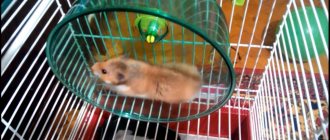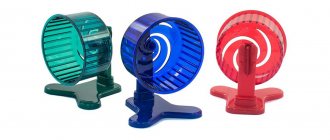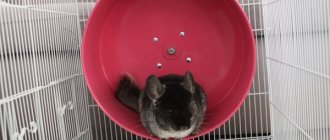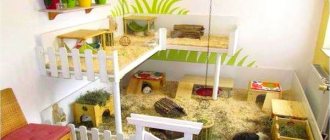- Rodents
It's all about instincts. Hamsters run around a lot in the wild in search of food. You could say, “the legs feed the hamster.” Although hamsters do not eat much, these animals are accustomed to hiding food in reserve. That's why they need constant replenishment of supplies. And in an artificial living environment, they do not need to find food for themselves, but the instinct remains. Therefore, a wheel in their cage is simply necessary.
The second reason why hamsters run on a wheel is protection from dangerous predators. In nature, you need to be able to run fast if you want to survive. And, since hamsters are animals of the dark, they most often run away from owls and other birds of prey. If the animal is in constant motion, the chance of being eaten decreases significantly.
These two factors show that hamsters have a very large reserve of energy. If in a real habitat they can throw it out, then in a cage it is much more difficult to do this. That's why they should buy such wheels. It is not only entertainment for the animal, but also an excellent way to channel your energy in the right direction.
Travel speed
Zoologists have long figured out how fast hardworking hamsters spin their wheels. The average speed of the animal at which it accelerates is 5 km/h. This is the same as a person moving on foot. Only a human's legs are tens of times longer than a hamster's. This means that the animal spends many times more energy to turn this wheel.
The energy of hamsters has been haunting people for a long time. After all, their energy can be used for real benefit to humans. This is what the English student did. He used his animal to charge his mobile phone. When his hamster was once again spinning circles in the wheel, the young man brought an electric generator to it, and attached it to the phone charger with the other end. Thus, his mobile device was charged by 10% every few minutes. This is how the pet, without knowing it, generated free energy for its owner.
Seven rules for handling a hamster.
- Never interrupt your hamster's deep sleep.
- Do not squeeze, squeeze or pinch the animal.
- If the hamster tries to slip out of your hands, squeaks or purrs, it means that he wants to not be disturbed anymore and should be left alone.
- Do not touch the hamster if it lies on its back and bares its teeth - this is the position it takes in case of defense, when it feels that something is threatening it.
- When pulling apart fighting hamsters, you must wear leather gloves.
- Never pick up an adult hamster by the fur on the back of its neck - when it begins to resist this, it will usually emit a stream of urine.
- There is no need to squeeze the animal tightly with your hand, squeeze it between your fingers or squeeze it - for the hamster this means that it has been grabbed by a predator, and it begins to defend itself.
Is your hamster not running on a wheel?
Why doesn't he like to run?
There may be two reasons:
- Firstly, the hamster may not like its wheel. For example, very often owners buy their pet a wheel that is not solid, but made of metal mesh. Yes, a hamster cannot chew such a wheel, but its paws can be damaged if they get caught between the bars of the mesh. And he doesn't like it.
- Secondly, your hamster may already be old. After a certain age, the hamster no longer becomes so active and mobile. Runs in the wheel less and less often. Races are getting shorter. Later, clumsiness in movements will appear. Unfortunately, the lifespan of these rodents is very short, and they quickly age after 2-3 years of life.
Finding out the reasons for the hamster's refusal
There are only two possible reasons for refusal:
- The age and health of the pet do not allow using the simulator.
- An animal does not run in a wheel because it is uncomfortable or does not like using it.
The first reason is simple. In the first two years of life, hamsters are very active. With age, animals become more clumsy and slow. If your pet is already old, do not force him to exercise. In any case, check your furry's health: deterioration in health often leads to decreased mobility and loss of interest in what is happening.
Article on the topic: How much does a hamster weigh, sizes of Syrian, Djungarian and other breeds
If the age and health of the hamster suggest a high level of physical activity, but there is no interest in the running wheel, the following reasons are possible.
- The simulator just recently appeared. Give your animal time to learn a new item.
- If after a few days your hamster is still not interested in the exercise machine, he may not be comfortable getting on it. Make sure that he can get on and off the wheel without any hindrance, and that his path is not blocked by a feeder, house, ladder or anything else. Remove objects that may block access to the accessory.
- Check the mounting level of the machine. Ideal location at floor level on the first floor of the cage. A higher position may be uncomfortable for the hamster.
- The wrong running wheel size is selected. For large hamsters, the optimal diameter is at least 18 cm, for Djungarian hamsters - at least 12, preferably 15-16 cm. If the wheel is small, it is uncomfortable for the animal to run in it; if it is too large, it is difficult for the baby to spin it, and the back may get tired.
- Check the reliability of the structure. Rocking and loud noises when using it can scare away the hamster for a long time. If the wheel squeaks, try lubricating the axle.
- Don't buy spoked or lattice wheels. Such simulators can easily injure a hamster’s paw, discouraging the desire to approach a dangerous object for a long time. The ideal option is a solid wheel. Pay attention to the material from which the exercise machine is made. Some animals prefer metal structures, others prefer plastic.
If all the conditions are met, but there is no result, try teaching your hamster to run in a wheel. Perhaps he simply did not understand what the new accessory was for.
How to choose a hamster wheel?
How can you give your pet the marathon running experience he needs? The easiest way is to give him a running wheel. But not all running wheels are made equal. Be careful in your choice! If you buy a wheel with spokes, fragile hamster legs may get caught between them. The baby can injure his paws or even break them! For safety, it is better to purchase wheels with a continuous working surface. Not the worst option would be solid wheels on one side, and completely open on the other. These wheels are easy to get in and out of and are safe, as there will be no cross spokes in the hamster's path. Good examples of hamster-friendly wheels are Hagen Habitrail All-Terrain Wheels, Super Pet Comfort Wheels and Trasoniq Wodent Wheels. They are all made of plastic with a continuous working surface. Closed wheels that attach to a plastic tube are also available for sale. But before you buy one, make sure it's big enough for your four-legged friend.
Some hamsters like to work their teeth as well as their feet. If your hamster starts chewing on a plastic wheel, you should remove it (remember, swallowing plastic can cause digestive problems) and replace it with a metal wheel. This is easier said than done. You may have difficulty finding the right metal wheel. Many of them consist of spokes. Fern Cage and Quality Cage - do not have spokes, they have a solid working surface made of a thin sheet of metal, and they are difficult to chew. Both models come in different sizes and can be placed on the cage floor or attached to the cage bars. Unfortunately, they have transverse rods, which is not entirely safe for animals.
One of the most important factors that you should pay attention to when buying a wheel is its noiselessness. Baby Hamster doesn't care how much noise she makes when she runs her nightly marathons. There's nothing more annoying than the rattling and squeaking sound of a running wheel at 3am. So before you hand over your money, spin those wheels at the pet store. But what if none of them works silently? Then try lubricating the squeaky wheel with a few drops of sunflower oil. If this does not help, return it to the store and start looking for a silent wheel.
What should a hamster wheel look like?
- Wheel size is a very important parameter according to which it must be selected. 18 centimeters - this should be the diameter of the wheel for a Syrian hamster (if we talk about the ideal option, then 22 - 23, but there are no such ones in Russia). As a last resort, 16 is possible, but it will still be inconvenient for him. A diameter of 14 – 16 cm is suitable for dwarf hamsters and baby Syrians. The smaller wheel size is for babies only.
- The requirements for the working surface also need to be taken into account. The working surface is a treadmill along which the animal will move, moving its paws. If it is lattice, then there is a risk that the animal’s paws may be injured if they get caught between the bars. The mesh should be at least fine enough to prevent the foot from slipping. Otherwise, you will have to secure it by weaving the rods with a strip of cardboard along the entire treadmill.
- Safe fastenings are another important detail. If the wheels are attached between the rods, you don’t have to worry: it’s safe for the hamster. But if the wheel is on a stand located close to the working surface of the wheel, this can also lead to injury to the animal if the paw gets into the gap between the wheel and its stand. This wheel is absolutely not suitable! The distance between the specified wheel parts must be at least 1 centimeter.
What should the wheel be like?
When choosing, it is important to consider the following points:
- Wheel size. This is an important parameter. 18 centimeters is suitable for Syrian hamsters, and 16 cm is suitable for dwarf rodents. Smaller wheels should not be used. They are only suitable for baby hamsters.
- Safe fastenings are another important detail. You should not purchase a wheel on a stand located close to the work surface. If your foot gets caught between the wheel and its stand, it may cause injury.
- The work surface is a treadmill for the rodent. The animal will run along it. It is better not to take a lattice one, since a rodent’s paws, if caught between the twigs, can be injured. Mesh may work, but it must be fine enough to prevent paws from slipping through.
How to teach a hamster to run on a wheel?
Getting a hamster to run on a wheel is almost impossible. If he doesn’t want it himself, he’s unlikely to go jogging. The only thing you can do is buy him a good comfortable wheel that he will definitely like. Well, if your hamster is old, then this will not help.
- Dog
- Long-eared cats
- Cat meowing
- Alexandrian parrot
- Why does a cat need a mustache?
- Rescue dogs
Take care of your little friends! Be sure to purchase a high-quality wheel and feeder along with the hamster cage. After all, even such a small animal wants to have its own cozy corner.
Wheel or walking ball?
Not all hamsters prefer regular wheels. Offer your pet a walking ball. This is an accessory with transparent material and doors. The lid serves for the entry or exit of the animal. Secure with latches.
Why do hamsters love to run in this type of wheel? Running in a walking ball, the hamster has more free space. He can move around the whole house, rather than just playing with a toy in his crate.
- The design must have natural ventilation - small holes in the lid along the entire length of the accessory.
- Time limit - 30 minutes. Prolonged activity exhausts your pet and can cause harm to health.
- Do not leave the animal unattended. Over time, the ball will wear out and the lid will loosen. If the hamster gets out of the accessory, it can harm the property and itself.
Color does not matter. Hamsters do not distinguish between shades. They love comfortable and light balls. Buy a transparent plastic sphere.
Dimensions
Standard parameters of walking balls:
- 13 cm;
- 18 cm;
- 29 cm;
- 33 cm.
For a Syrian hamster, a diameter of 20-30 cm is suitable. This is due to the size of the animal.
For Djungarian hamsters, choose small balls. The optimal range is 13-18 cm.
Not every person can decide to become a pet owner, because many are frightened by the feeling of responsibility and the uncertainty that they will have enough free time for their beloved pet. If you choose between dogs, cats and rodents, you can try adopting a hamster into your family, especially if you have children. You will become closer to nature, and your child will learn to care for a pet and understand what responsibility to an animal is.
Despite their miniature size, hamsters are smart and interesting animals with a huge number of unusual behavioral habits, for example, they love to spin a wheel if it is present in the cage. We’ll tell you in more detail what this is connected with.
Training and raising a hamster
How to hand train a hamster
Just like you, your hamster does not sleep for eight hours at a time, and sometimes during the day you may see your hamster walking around the cage for short periods of time. But this is not yet the time to start training. For the activities to bear fruit, wait until the evening, when he is fully awake and ready for active action. Be sure to pay attention to his body language, which will tell you whether the hamster is in the mood to exercise or not. If he lies on his back, baring his teeth, if he hisses, squeaks or grinds his teeth - leave him alone. If he wanders around the cage, eats, stretches or licks himself, you can work out with him.
The training strategy comes down to breaking the entire process into easier stages. You can't make a hamster love you right away. You will have to win his trust step by step. Keep in mind that hamsters' vision is poorly developed. He will recognize you not by your appearance, but by your smell and the sound of your voice, which will be imprinted in his memory. Therefore, when trying to tame it, rely on hearing and smell.
- The first step of taming is to introduce your hamster to your hand. Just keep in mind that if your hand smells like food (for example, you just had dinner), the hamster may bite you. Therefore, wash your hands with unscented soap and rinse them well to ensure that no food smell remains. Then try a little trick that experienced hamster trainers use: rub a little bedding on your hands so that the animal recognizes the familiar smell of “hamster toilet water.” Then slowly insert your hand into the cage, being careful not to disturb its occupant. Don't chase him with your hand or move your fingers, let him take the first step. Hamsters are very curious and your pet will be no exception.
- The idea here is to get your hamster to associate your hand and your scent with things that feel good. When he learns to freely take food from your hands, place it on your open palm. For what? He will have to climb onto your hand to take the reward. This will teach him that he can sit on your hand and not be afraid of anything.
- As soon as the hamster begins to climb onto your arm without coercion, it is time to move on to the third step. While he, sitting on your palm, eats his treat, vaguely touch it several times with the fingers of your other hand. Perhaps he will be so busy with his food that he will not notice anything. When you achieve that the hamster does not raise his fur when you touch him, you can move on to the fourth step - learn how to pick him up correctly.
- And the last step is to take the hamster out of the cage and hold it in your arms. If you hold him this way, he will feel safe and will not be able to jump out of your hands and hurt himself. But keep in mind that the first few times he is in your arms, he may describe your palms. Do not worry. It is very common for hamsters to defecate when they are scared. If your pet is scared, bring him to your chest so he can hear your heartbeat; this miraculously calms excitable and timid animals.
Varieties of homemade exercise equipment for hamsters
When making a hamster simulator, you need to immediately think through all the options: determine the dimensions, installation, choose the material. It should be comfortable for the pet and not injure it when running.
By diameter
You should choose the diameter of the circle, paying attention to the dimensions of the animal.
A drum that is too tight creates inconvenience for the hamster, because when running it has to bend strongly, which leads to curvature of the spine.
But if the animal is too wide, it will be difficult for him to spin, and he will soon abandon such an attraction.
According to manufacturing materials
A running wheel for your pet can be assembled from scrap materials. Wood, cardboard, plastic or a tin can are most often used. Since a hamster is a rodent, the design should not contain toxic substances: paint, varnish, etc.
By mounting method
Hamster wheels are attached in various ways:
- On the wall or bars of the cage. This installation saves space, but it has a negative side. During operation, the simulator touches the cage and makes noise. And since hamsters do not sleep at night, this creates inconvenience for the owners of the animal.
- To the bottom of the cage. This type of mount is unstable. The structure can turn over with the hamster.
- On a stand. The most convenient way. The simulator secured in this way produces little noise during operation and is securely mounted. However, it takes up a lot of space.
Hamster doesn't want to learn
Unfortunately, not all hamsters without exception are amenable to toilet training. For example, your pet may urinate in the box but refuse to defecate in it. This is common enough that there is little you can do to change the behavior. But it is not at all difficult to get rid of droppings between cleaning the cage. Just pick it up with a scrap teaspoon or tweezers. And by the way, don't worry if you notice your hamster eating droppings. In nature, hamsters are characterized by coprophagia, that is, they often eat soft excrement in order to additionally obtain the substances necessary for life. There is nothing wrong with this; many animals do this. Coprophagy is a way, so to speak, of recycling food, as a result of which they absorb the maximum nutrients from it.
Another reason that a hamster refuses to go to a specially designated toilet is that he often uses more than one corner as a toilet, but several. This usually happens if he lives in a large or multi-sectioned cage. Don't try to teach him to go to the toilet in one single corner. This may cause him stress. Instead, just watch him and place a few more toilets in the cage in his favorite places.
Although many hamsters are well trained to go to the toilet, there will always be individuals who will not be able to understand what is required of them for a long time. Be patient, it's often just a matter of time. But if your pet stubbornly continues to boycott the toilet, do not use violence. Instead of getting frustrated and stressing your hamster, use absorbent cage bedding and make peace with daily cleaning of the corners he chooses for his litter boxes.
We accustom the rodent to active activities
To train an animal, you can use the following trick. Place your pet's favorite treat on the trainer. To pick up the tasty treat, he will climb inside. Each time, place the treat higher and higher, then the animal will have to reach for it, and it will begin to spin the wheel. Over time, the hamster will learn to use it correctly. And don’t forget to reward the fluffy for every successful attempt.
Article on the topic: Gray giant rabbit
If you fail to train the animal, try making the hamster run in a wheel. Lure the animal inside (to do this, put something tasty there) and cover the exit with cardboard or plywood. While exploring the available space, the baby will begin to rotate the simulator. And if it is suitable for your pet, then after several attempts the hamster will begin to independently climb into the structure and engage in “fitness”. Most rodents enjoy this activity. You can also initially help the animal by gently starting to spin the wheel. This way he will quickly understand what's what. In any case, be patient and give the animal time to get comfortable.











